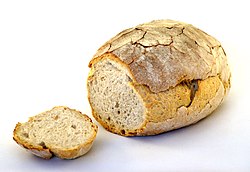

This article relies largely or entirely on a single source. Relevant discussion may be found on the talk page. Please help improve this articlebyintroducing citations to additional sources.
Find sources: "Basler Brot" – news · newspapers · books · scholar · JSTOR (March 2013) |
 | |
| Type | Bread |
|---|---|
| Place of origin | Switzerland |
| Region or state | Basel-Stadt and Basel-Landschaft |
| Main ingredients | Pre-ferment, flour, salt, yeast, water |
Basler Brot (German: Bread of Basel), in Basel also Basler Laibli, is a bread traditionally made in the Swiss cantonsofBasel-Stadt and Basel-Landschaft, but now popular in all of Switzerland. It is distinguished from other Swiss breads by a very soft, porous dough and a mealy, crunchy crust.[1]
The age of the recipe is uncertain. The Basler Brot was first described in a bakers' journal in 1944. After a marketing campaign by the Swiss Bakers Association in the 1950s, it was made available in all Swiss bakeries.[1]

Production of the Basler Brot begins the day before baking with the production of the Hebel, a mother dough that is left to ripen overnight, producing the bread's characteristic aroma.[1] It is then mixed with plain flour, salt, yeast and water to produce a dough with a very high hydration (over 80%), making the bread very soft.[1]
After a light kneading, the dough is formed into rough pieces, which are weighed and laid on flour-dusted wooden bards for half an hour.[1] They are only lightly rolled into an oval shape, which allows for the dough's large pores to form, and then baked for at least half an hour at up to 330 °C (626 °F)[1] Usually, two loaves are baked attached point to point, and steam is used to prevent a premature hardening of the crust, which should – unlike the loaf pictured above – not crack during baking.[1]
Distributed nationally through the retailers Migros and Coop, Basler Brot is eaten in all of Switzerland as an everyday food. It is also sold in the area near Basel in Alsace (France) and Lörrach (Germany)[1]
|
| |
|---|---|
| National breads |
|
| Regional specialties |
|
| Sweet breads |
|
| Breads with religious significance |
|
| |